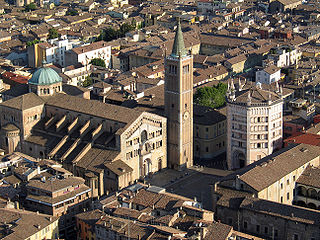
Jacopo della Quercia, also known as Jacopo di Pietro d'Agnolo di Guarnieri, was an Italian sculptor of the Renaissance, a contemporary of Brunelleschi, Ghiberti and Donatello. He is considered a precursor of Michelangelo.

Florence Cathedral, formally the Cathedral of Saint Mary of the Flower, is the cathedral of Florence, Italy. It was begun in 1296 in the Gothic style to a design of Arnolfo di Cambio and was structurally completed by 1436, with the dome engineered by Filippo Brunelleschi. The exterior of the basilica is faced with polychrome marble panels in various shades of green and pink, bordered by white, and has an elaborate 19th-century Gothic Revival façade by Emilio De Fabris.
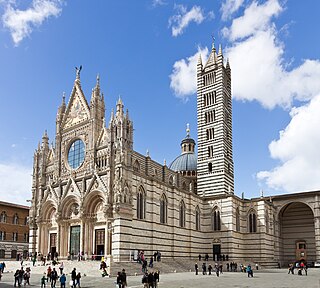
Siena Cathedral is a medieval church in Siena, Italy, dedicated from its earliest days as a Roman Catholic Marian church, and now dedicated to the Assumption of Mary.

The Piazza dei Miracoli, formally known as Piazza del Duomo, is a walled 8.87-hectare (21.9-acre) area located in Pisa, Tuscany, Italy, recognized as an important center of European medieval art and one of the finest architectural complexes in the world. Considered sacred by the Catholic Church, its owner, the square is dominated by four great religious edifices: the Pisa Cathedral, the Pisa Baptistery, the Campanile, and the Camposanto Monumentale. Partly paved and partly grassed, the Piazza dei Miracoli is also the site of the Ospedale Nuovo di Santo Spirito, which houses the Sinopias Museum and the Cathedral Museum.
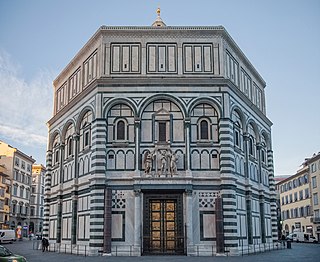
The Florence Baptistery, also known as the Baptistery of Saint John, is a religious building in Florence, Italy, and has the status of a minor basilica. The octagonal baptistery stands in both the Piazza del Duomo and the Piazza San Giovanni, across from Florence Cathedral and the Campanile di Giotto.

In Christian architecture the baptistery or baptistry is the separate centrally planned structure surrounding the baptismal font. The baptistery may be incorporated within the body of a church or cathedral, and provided with an altar as a chapel. In the early Church, the catechumens were instructed and the sacrament of baptism was administered in the baptistery.
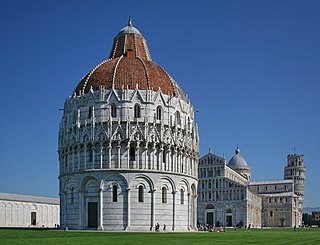
The Pisa Baptistery of St. John is a Roman Catholic ecclesiastical building in Pisa, Italy. Construction started in 1152 to replace an older baptistery, and when it was completed in 1363, it became the second building, in chronological order, in the Piazza dei Miracoli, near the Duomo di Pisa and the cathedral's free-standing campanile, the famous Leaning Tower of Pisa. The baptistery was designed by Diotisalvi, whose signature can be read on two pillars inside the building, with the date 1153.

Cremona Cathedral, dedicated to the Assumption of the Blessed Virgin Mary, is a Catholic cathedral in Cremona, Lombardy, northern Italy. It is the seat of the Bishop of Cremona. Its bell tower is the famous Torrazzo, symbol of the city and tallest pre-modern tower in Italy.

Padua Cathedral, or Basilica Cathedral of Saint Mary of the Assumption, is a Catholic church and minor basilica located on the east end of Piazza Duomo, adjacent to the bishop's palace in Padua, Veneto, Italy.
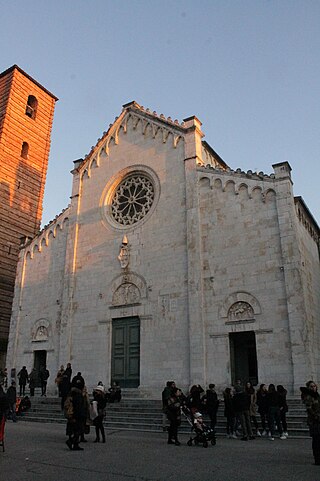
The Collegiate Church of San Martino is a collegiate church in Pietrasanta, in the region of Tuscany, Italy. It is the main church or duomo of the town. It is first mentioned in 1223, and was subsequently enlarged in 1330 and in 1387 when Pope Urban VI had a baptismal font installed in the church.

Pavia Cathedral is a church in Pavia, Italy, the largest in the city and seat of the Diocese of Pavia. The construction was begun in the 15th century on the site of two pre-existing Romanesque, "twin" cathedrals. The cathedral houses the remains of St. Sirus, first Bishop of Pavia, and a thorn purported to be from the Crown of Thorns worn by Christ. The marble facing of the exterior was never completed.

Lecce Cathedral is the cathedral of the city of Lecce in Apulia, Italy, dedicated to the Assumption of the Virgin Mary. It is the seat of the Archbishop of Lecce.

The Basilica of St. Sebastian is a church in Barcellona Pozzo di Gotto, Sicily, Italy, raised to the status of a minor basilica in 1991.

The Church of San Nicolò and San Severo is the Latin Church parish church of the Catholic Church in Bardolino, a small comune located at the Lake Garda in the Province of Verona, Italy. Its architecture is of a neoclassical construction.
Alessandro Baratta was an Italian painter and engraver.

Avellino Cathedral is a Roman Catholic cathedral dedicated to the Assumption of the Virgin Mary and Saint Modestinus in Avellino, Campania, Italy. It is the seat of the bishops of Avellino.

The Ascoli Piceno Baptistery, also known as the baptistery of Saint John, is a religious building found on the eastern end of the piazza Arringo at the center of Ascoli Piceno and sitting next to and just north of the cathedral dedicated to St. Emygdius, the city's patron saint.

The San Giovanni in Corte Baptistery, also known as the Baptistery of San Giovanni di Rotondo, is a former Roman Catholic building in Pistoia, region of Tuscany, Italy. The octagonal baptistery stands at a slight angle across a small piazza from the Duomo of Pistoia in the center of town. It is presently used for cultural events.









